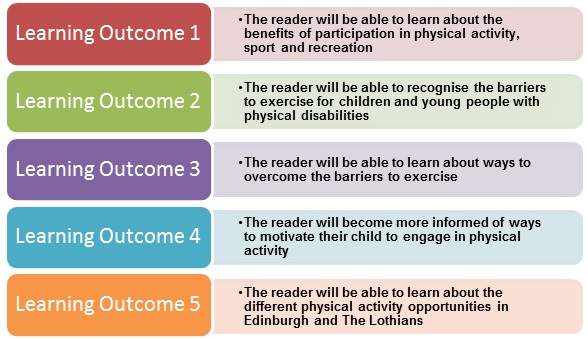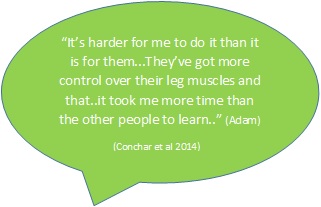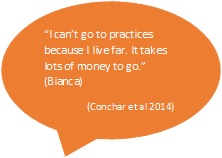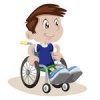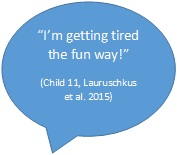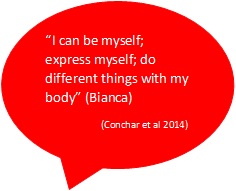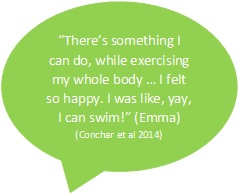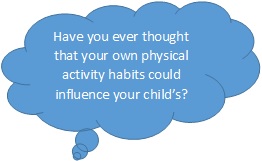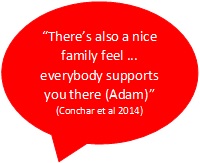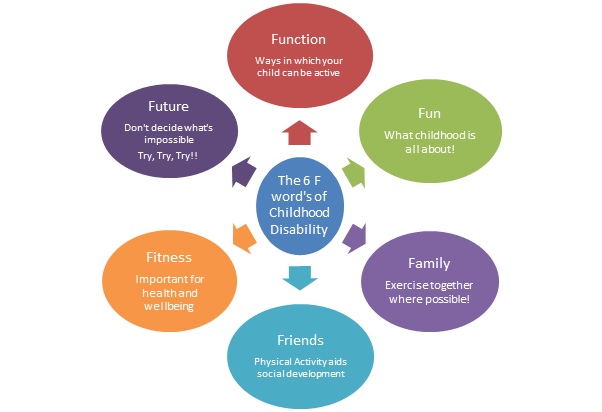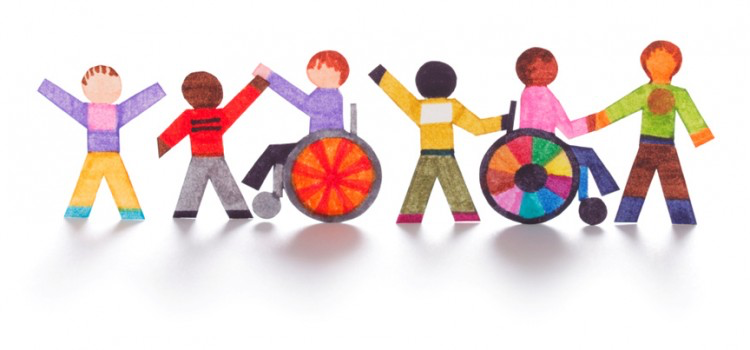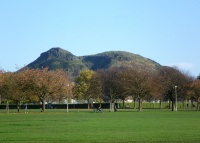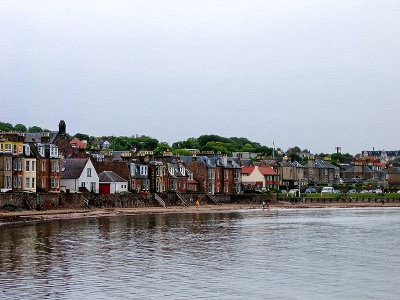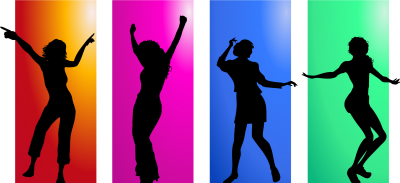Physical Activity, Sport and Recreation for Young People with Physical Disabilities
Introduction[edit | edit source]
The aim of this online resource is to provide parents of young physically disabled people with information regarding the importance of physical activity in their child’s lives, along with current sporting and recreational opportunities available for their children in Edinburgh and the Lothian’s. The following will take you through the health benefits of physical activity, possible barriers to your child being physically active, along with facilitators to participation. It hopes to provide a one stop resource with all the key information parents require to engage their children in the variety of physically active opportunities in the Lothian area. Throughout this resource Theo will encourage you to reflect your thoughts by allowing you to question yourself.
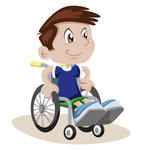 "Hi I'm Theo and I am going to help take you through this online resource!"
"Hi I'm Theo and I am going to help take you through this online resource!"
Learning Outcomes[edit | edit source]
Physical Activity[edit | edit source]
What is Physical Activity and How Much is Enough For My Child?[edit | edit source]
Did you know that physical activity is any movement made by your body that uses energy? (WHO, 2016)
So how much physical activity do you think is actually enough?
Your child should aim to take part in at least one hour of medium to hard intensity physical activity every day. (WHO, 2016) These are types of activities which may make your child work up a sweat. Taking part in them will speed up your child’s heart rate and will warm up their body for further activities. They will also leave your child feeling a little out of breath; but don’t worry, it is completely normal. Examples of such activities are swimming, dancing and cycling. Your child should aim to take part in these types of activities at least two to three times a week, to improve their heart and bone health, muscle strength and overall flexibility. (NICE GUIDELINES 2016).
These guidelines are set out for children in general. If your child has a disability or medical condition, activities and exercises should be adapted according to what they can do.
If you are concerned about the amount and type of physical activity that would be suitable for your childs abilities click <a href="https://health.gov/paguidelines/pdf/paguide.pdf">here</a>, or if you are still unsure, you can get further information from your local G.P or a physiotherapist. Your G.P and also Physiotherapists will play a major role in promoting P.A options for you and your child with a disability.Would you believe that people with disabilities were 82% more likely to engage in P.A if a doctor or physiotherapist recommended it, ‘Centres for Disease Control and Prevention’ (2016).
In Summary[edit | edit source]
- It is most important your child participates in an appropriate amount and type of P.A to suit their ability.
- Your child should begin slowly, based on their ability and current level of fitness, e.g. begin with 10 minutes of regular activity if your child has been inactive for some time, gradually increase the amount of time, followed by increasing the intensity of the activity
- Include aerobic activities to increase your childs’ breathing and heart rate
- Familiarise yourself with adaptations and modifications for your child, and be comfortable making alterations where necessary
- Always avoid your child being inactive, any P.A is better than none!
More Benefits of Physical Activity!
[edit | edit source]
Now, just incase we haven’t convinced you just yet to sign your child up (or yourself!) to some sort of P.A, here's a few more reasons why you should get those running shoes on, and get your body moving…!
http://www.who.int/topics/physical_activity/en/
- It boosts confidence and self-esteem, and makes you feel good and happy in yourself
- It helps to control weight - (so you wont feel as guilty for having that extra donut!)
- Improves gross and motor skill development, e.g. assists with writing (REF EMCK)
- Improves their ability to be competent in school and in P.A (REF EMCK)
- Increases their adjustment towards their feelings and emotions (REF EMCK)
- Improves muscular and cardiorespiratory fitness
- Improves bone and functional health
- Reduces the risk of falls and fractures
- Physically active wheelchair users tend to go to hospital less than those wheelchair users who don’t do P.A.
- Wheelchair athletes who do P.A have fewer pressure sores and kidney complications than wheelchair users who don’t do P.A
- P.A also has a lessening effect on challenging behaviour (Moon et al, 1982; Nishiyama et al, 1986; Lancioni et al, 1994 and 1998; Washburn et al, 2002; Nary et al, 2000 cited by Boland, 2005).
- P.A is important in maintaining fitness for daily living, reducing functional limitations, helps with independent living and preventing, delaying and reducing chronic illnesses and secondary conditions (Fentem, 1994).
What If My Child Has Cerebral Palsy?[edit | edit source]
You may want to consider the following if your child has cerebral palsy:
Children with cerebral palsy are said to participate in lower levels of P.A than any other child, and they are beginning to show an increase in mobility problems as a result of this decreased P.A level. 2,3,4,5 Some of the things you might also want to remember if this is the case with your child, they are more likely to be less fit than others, more likely to have issues with their mobility down the line, and reduced muscle tone. However, not to worry, this can all be prevented by participating in regular activity weekly, rather sooner than later to avoid this inactivity creeping further into their teenage years!6
“Physical activity stimulation program for children with cerebral palsy did not improve physical activity: a randomised trial “Leontien Van Wely, Astrid CJ Balemans, Jules G Becher, Annet J Dallmeijer (REFERENCES 2,3,4,5 & 6 USED)
What Can Happen If My Child Doesn't Exercise?[edit | edit source]
Now take a look at some of the more serious health risks associated with inactivity, would make you think eh?
- Not having enough P.A is 1 of the 10 leading risk factors for death across the world and is on the rise in many countries, adding to the burden of NCDs (noncommunicable diseases, i.e cardiovascular disease, cancer and diabetes) and affecting general health worldwide.
- People with disabilities are three times more likely to have the above complications than those without disabilities, but thankfully aerobic P.A can help reduce the impact of these complications. http://www.cdc.gov/ncbddd/disabilityandhealth/pa.html
- People who are less active have a 20% to 30% increased risk of death compared to people who meet the above P.A recommendations.
- Inactivity can also lead to an increase in needing others, a decrease in socialising with friends and becoming more tired, feeling low or upset, putting on weight and an increase in pressure sores.
- Physical inactivity increases the risk of coronary heart and cerebrovascular diseases, type 2 diabetes mellitus, hypertension, stroke, several cancers (e.g. lung, prostate, breast, colon, others), osteoporosis/fractures, depression and dementia, among others.
Interested In Some Random Facts About Inactivity?[edit | edit source]
- Globally, 1 in 4 adults is not active enough.
- More than 80% of the world's adult population doesn’t do enough physical activity.
- Policies to address insufficient physical activity are operational in only 56% of WHO Member States.
- WHO Member States have agreed to reduce insufficient physical activity by 10% by 2025.
- Globally, 81% of adolescents aged 11-17 years were insufficiently physically active in 2010.
- Adolescent girls were less active than adolescent boys, with 84% vs. 78% not meeting WHO recommendations.
- Globally, around 23% of adults aged 18 and over were not active enough in 2010 (men 20% and women 27%).
- In high-income countries, 26% of men and 35% of women didn’t do enough physical activity, as compared to 12% of men and 24% of women in low-income countries.
- The drop in P.A is partly due to inaction during leisure time and sedentary behaviour on the job and at home.
- Likewise, an increase in the use of "passive" modes of transportation also contributes to insufficient physical activity.
How Much Exercise Do Parents and Grandparents Need?[edit | edit source]
So, after becoming aware of the importance of P.A and the effects of not being active enough, would this cause you to think about your own P.A levels? If so...here is some more information for parents and grandparents who want to spend time being physically active with their children and grandchildren!
Parents and Grandparents Aged 18-64 Years[edit | edit source]
- Adults aged 18-64 should do at least 150 minutes of medium intensity, and at least 75 minutes of hard P.A throughout the week, or a combination of medium and hard activities.
- If you want to go that extra mile, adults should increase their medium intensity P.A to 300 minutes per week, or equivalent.
- Muscle-strengthening activities should be done involving major muscle groups on 2 or more days a week.
Parents and Grandparents Aged 65 Years and Above[edit | edit source]
- Do at least 150 minutes of medium intensity P.A or at least 75 minutes of hard P.A throughout the week, or an equivalent combination of medium and hard activities.
- Again, to go that extra mile, you should increase medium intensity P.A to 300 minutes per week, or equivalent.
- If you consider yourself to have poor mobility, you should still perform P.A to improve your balance and prevent falls, 3 or more days per week.
- Muscle-strengthening activities should be done involving major muscle groups, 2 or more days a week.
- The intensity of different forms of P.A varies between people. In order for P.A to benefit your cardiorespiratory health, all activities should be performed in bouts of at least 10 minutes duration.
Barriers and Facilitators to Exercise[edit | edit source]
Barriers: Things That Get In The Way[edit | edit source]
By now you are well aware of how important it is for everyone take part in physical activity, but we all know it’s not always that simple when your child has additional support needs. You may find a number of things get in the way when you are trying to enable your child to take part in activities.
Here are some barriers you may come across…
Physical Barriers[edit | edit source]
- Your child’s disability may make taking part in physical activity more difficult as it may limit range of movement at joints, flexibility, agility, strength or endurance. Your child may also have issues with balance and coordination; if they do, you might find that they have a fear of falling when engaging in sports. (Conchar et al. 2014) Any of these limitations, may demotivate your child from taking part in more activities.
- Pain and fatigue may also limit your child from being active. They can often be due to training, sitting for long periods or wearing their assistive devices such as an orthosis. (Conchar et al. 2014)
- Your child may take more time to go outdoors during school breaks if they have to handle and wear orthoses. They may see it as an inconvenience and may stop using this time to play outside with their friends. (Lauruschkus et al. 2014)
- Physical strength and skills that your child has developed may be lost due to interruptions in training or recovery after surgery. (Conchar et al. 2014)
- As your child gets older, the gap between able-bodied children and disabled athletes in terms of physical strength and agility grows larger. With this, the skills gap also widens and sports become more competitive. As a result, it may become more difficult for your child to continue taking part in mainstream activities. (Conchar et al. 2014)
Psychosocial And Emotional Barriers
[edit | edit source]
- Embarrassment, vulnerability, disappointment and shame at appearing physically incapable are just some of the uncomfortable emotions your child may experience. These feelings may lower their confidence and self-esteem. They may also feel frustrated at taking longer to learn a new skill and as a result, may avoid taking part in certain activities altogether. (Conchar et al. 2014)
- Negative attitudes from parents, staff and peers can hinder your child’s interest in physical activity. (Jones, 2003). It may come in the form of teasing from other children and/or teachers who lack training in adapting activities to suit your child needs. This also results in excluding them from taking part in school clubs and activities. (Shields and Sinnot 2012)
- As a result, your child may feel singled out and alone. These feelings can sometimes lead them to believe they are not good enough and can make it more difficult for them to persevere with physical activity. (Lauruschkus et al. 2014)
Cost and Environmental Barriers[edit | edit source]
- Finding time in the midst of appointments with various therapists, school runs, caring for other children, along with day-to-day duties poses as one of the main barriers to including physical activity in your child’s life. With the extra expenses of caring for a child with a disability and fewer earnings due to taking on caring responsibilities instead of work, there is often little money leftover to spend on membership for various classes and clubs. (Shields and Sinnot 2012)
- Sporting opportunities specific to your child’s abilities, as well as those available in your local area are often poorly advertised. Lack of available information means you may have to rely on word-of-mouth or carry out your own research to learn about new opportunities for your child. (Jaarsma et al. 2014, Shields and Sinnot, 2012)
- Sporting facilities that cater for your child’s needs are often lacking in certain areas such as a shortage of qualified staff willing to supervise activities for children with motor impairments and an undersupply of equipment to aid sports, especially as your child gets older. (Shields and Sinnot, 2016, Lauruschkus et al., 2014)
- Unfortunately, local clubs and societies may also face difficulties such recruiting enough children to make up teams or finding other teams to play against. (Conchar et al. 2014)
- With this comes the barrier of transport. Living far away from such facilities and having to travel to introduce your child to such activities, may not be always be easy to access via public transport. (Conchar et al. 2014)
- One off programmes in addition to long waiting lists for specialised classes may also pose as a barrier to your child’s participation in physical activity (Shields and Sinnot, 2012).
- Specialised adaptive equipment for sports is also costly and not always readily available. (Rimmer et al. 2004)
- Environmental barriers may also get in the way to accessing sporting facilities. These may include lack of curb cuts and ramps, doors being too narrow for wheelchair access and reception desks being too high to talk with staff.
Facilitators: What Can Make It Easier[edit | edit source]
Do you feel you can identify with some of these barriers? Here are some ways in which you motivate and help enable your child to engage in sports and other activities.
Personal Facilitators[edit | edit source]
- The health benefits of physical activity may not be motivating factor for young children to exercise; however, finding an activity that provides fun and enjoyment is very important in facilitating and maintaining a physically active behaviour (Shields et al 2011).
- The sensation of speed is something that children have reported as an enjoyable feeling, thus proving to be an internal motivator. Therefore providing your child the opportunity to experience this feeling, be it through running, swimming, dancing, cycling, rolling on a ball or bouncing on a trampoline can be a key start to introducing a physically active behaviour in your child (Lauruschkus et al, 2015).
- The feeling of being physically capable, along with the sense of achieving mastery in their chosen activity is crucial to building self-efficacy; a important factor in adopting a physically active behaviour (Conchar et al, 2014).
- Finding activities that your child feels they can perform independently and well provides them with a sense of pride and accomplishment, further motivating them to be physically active.
- Since children also enjoy “showing off” every now and again, playing games with a competitive spirit can often be a good way to get them involved in physical activity.
- Desirable changes in body image along with improvements in physical function, such as becoming stronger, fitter and more agile can be a big motivator for your child. It can improve their ability to move around and thus become a vital motivating factor as it allows them to become more independent, gives them a sense of ownership over their own body and may also reduce the need for occupational therapy and physiotherapy. (Conchar et al, 2014)
Social Facilitators[edit | edit source]
- Studies haven shown that children (aged 4-7) of physically active mothers are twice as likely to take part in physical activity than children with inactive mothers. The are also 3.5 times more likely to engage in physical activity if they have active fathers. Those with two active parents are almost 6 times more likely to be physically active than children of inactive parents. (Moore et al. 1991) As a parent, you are the most influential role model to your child. That’s why your own behaviours and the value you place on physical activity will directly impact the level of your child’s participation in sports and activities. (Trost et al. 2003)
- If you have managed to introduce a physically active lifestyle from a young age - that’s great! However, maintaining this lifestyle can be challenging as your child grows older. Parental support is also thought to be a key factor in maintaining physically active habits (Dowda et al. 2007) Thus, the importance you place on your child’s physical activity levels, along with the encouragement and support you provide, is essential in facilitating your child to maintain an active behaviour. This involves your willingness and ability to provide transport to practices and competitions, and showing support and appreciating their achievements in order to aid participation. (Conchar et al, 2014)
- As a parent, you are also in charge your child’s daily schedule. Why not reduce screen time during the day and encourage your child to go outside and play? Factor in the time taken to go to the park or a class to include physical as a daily requirement.
- Habits of friends and siblings can also impact your child’s decision to take part in activities. Children enjoy belonging to something or someone; taking part in activities with family and friends can give them a feeling of togetherness and of being noticed and accepted part of a group. (Lauruschkus et al, 2015) It also gives children the opportunity to meet others with similar abilities and most importantly to be seen as more than their disability!
What's Key To Remember?[edit | edit source]
To sum it up, keeping these six Fs of childhood disability in your mind will help you remember what's most important to them and the key motivators to encouraging your child to being physically active!
Funding[edit | edit source]
As mentioned, cost can be big barrier to taking part in sport; therefore, this section will guide you to organisations, foundations and trusts in Scotland that can financially support your family and enable your child to take part in the sports and activities of their choice.
General Funding[edit | edit source]
Sports Aid Scotland[edit | edit source]
Sports Aid Scotland gives grants to talented young adults (aged 12-22) who take part in sports and disability athletes (aged 22-45) who are representing Scotland at a national level. The grant covers costs for training and travelling.
Dream It Believe It Achieve It (DBA)[edit | edit source]
DBA supports anyone with a physical disability regardless of their abilities; they have helped complete beginners as well as Paralympains by offering financial support for specialist training, equipment, and competitions.
Email: [email protected]
Telephone: 0844 414 8288
ECAS Edinburgh[edit | edit source]
You can apply for a transport grant from ECAS Edinburgh to attend their tai chi, yoga and swimming classes.
Take a Break[edit | edit source]
If you are a parent/carer of a disabled young person (aged 20 and under) who lives at home, you can apply for a grant from Take a Break. It can be used to cover costs for outings, leisure activities and sporting equipment. Grants are usually from £200-400 and have previously been used for gym memberships, horse riding and football equipment.
The Stanley Morrison Trust[edit | edit source]
The Stanley Morrison Trust supports charities and community groups by sponsoring events that encourage young people to become more active. No exclusion criteria was provided.
Telephone: 0141 578 2252
Get Kids Going![edit | edit source]
Get Kids Going! enables young people (aged 26 and under) to take part in disability sports by providing funding for specialist wheelchairs. They accept applications from individuals of all abilities - from complete beginners right up to Paralympians. The charity also gives sport grants to cover the costs of training, travelling, physiotherapy and competition fees.
For an application form, email: [email protected]
The Adam Millichip Foundation[edit | edit source]
The Adam Millichip Foundation helps cover costs for disabled people who want to improve their quality of life by taking part in sports and activities. However, they do not fund gym memberships. To apply here, your child needs to have the following: contact details, evidence of their medical condition, funding information and a personal statement. Medical confirmation by a doctor is also needed, but this can be provided later.
Telephone: 07866 424286
The Richard Overall Trust[edit | edit source]
Set up in memory of Richard who had Duchenne Muscular Dystrophy, the Richard Overall Trust supports disabled children and young adults to engage in and enjoy sport. They provide funding for training, sports clothing, transport, specialist equipment and sporting event tickets. Applications can be made by individuals, groups, families and carers. They also need a supporting letter from either a physiotherapist, occupational therapist, GP or teacher. You can download the application form from their website.
Equipment Funding[edit | edit source]
The Dan Maskell Tennis Trust[edit | edit source]
The Dan Maskell Tennis Trust supports disabled people that wish to play tennis by providing grants for specialist wheelchairs. They are accept applications from individuals, clubs, schools and active disability programmes. You can complete the application online or by hand.
Dates of trustee meetings and application deadlines are as follows:
15/03/17 (closing date for applications is 16th February, 2017)
06/06/17 (closing date for applications is 9th May, 2017)
27/09/17 (closing date for applications is 30th August, 2017)
Wheel Appeal[edit | edit source]
Wheel Appeal provides new sport wheelchairs, training and coaching for disabled children and adults. They help cover the costs of manual sport wheelchairs, hand cycles and hockey sledges by providing grants up to £1,500. Applicants may be asked to contribute £250 towards their equipment. To apply, you need to sign up for a free membership on Wheelpower. Once you have completed your child’s application, it needs to be supported by a statement from a recognised sport club, school, sport body or spinal unit.
Caudwell Children (Enable Sport)[edit | edit source]
Caudwell Children provide funding for sporting equipment for young, disabled individuals (aged 19 and under). They only accept applications from children of families with an annual income of £45,000 or less. They also need a statement from the club/coach for proof of involvement in a sport is and from a health professional for confirmation of disability.
The Adamson Trust[edit | edit source]
The Adamson Trust helps cover costs of holidays and respite breaks for children with disabilities (aged 17 and under). The planned holidays have activities such adapted abseiling and canoeing. You can download the short application form from their website; the application must be completed and sent off by 31st December, 2016 in order for it to be discussed at the meeting of the trustees in February.
Holiday Grants[edit | edit source]
Are you planning a holiday? If you want to learn about funding for respite holidays and applying for family holiday grants then head over to disability-grants.org.
Opportunities In Lothian[edit | edit source]
As a parent, regardless of whether your child has a physical disability, you will often worry about how to provide the best opportunities for your child. By now, you should know that physical activity plays a very important part in every person’s life.
Take a moment to think about how active you are as a family.
Every family is different. Some families lead very active lifestyles, but find it hard to include their child when taking part in certain activities. Others may be a lot less active and then the challenge becomes even greater.
This section will explore a number of different sports and activities. It will also direct you to the opportunities out there for your child and family to become more physically active.
( ) Areadne. Towards the inclusive classroom: best practice [Picture]. 2015. Available from: http://www.areadne.eu/course/towards-the-inclusive-classroom-best-practice/ [Accessed on 23rd November 2016]
Indoor Sports[edit | edit source]
Swimming[edit | edit source]
Have you ever thought about swimming for your child, but were unsure whether swimming pools near you cater to the additional support needs your child may have? Edinburgh Leisure offers Disability Swim in three locations across Edinburgh. The information for these is as follows:
Dalry Swim Centre: Wednesdays from 10:30am - 11:30am
Dumbrae Leisure Centre: Mondays from 11:00am - 12:00pm
Warrender Swim Centre: Mondays from 10:30am - 11:15am
Prices: Standard £5, Discount card £3.75, Junior and Disability Discount card £2.50.
Go to their website and book some sessions!
Wheelchair Basketball[edit | edit source]
Does your child prefer a team-based sport perhaps? Why not give wheelchair basketball a try? Playing this fully inclusive, fast-paced game is a great way for your child to stay physically active, build their self-esteem and make new friends.
Hear what parents and kids have to say about wheelchair basketball:
If your child wants to shoot hoops, Lothian Phoenix Wheelchair Basketball Club (LPWBC) offers weekly training for children at the following site in West Lothian:
Armadale Academy: Thursdays from 7:00pm - 7:45pm
To get in touch with LPWBC and learn more about the rules of wheelchair basketball, visit their website.
( ) Newsocracy. Wheelchair Basketball is a Game Changer for Mississippi Kids [Video]. 2014. Available from: https://www.youtube.com/watch?v=YRw3ztn24MY [Accessed on 23rd November 2016]
Judo[edit | edit source]
How about something more rough and tumble? Practicing judo can help build physical and mental toughness and improve self-confidence. If your child is interested in judo, Jidel Judo Club (JJC) run training sessions specifically for individuals living with disabilities at the following locations:
Craigswood Sports Centre (Livingston): Mondays from 6:45pm - 7:30pm
Napier University (EN)GAGE Sports Centre (Edinburgh): Tuesdays from 7:00pm - 7:45pm
To book a taster session and learn more about the classes at JJC, head over to their website or call 07411 722240.
Badminton[edit | edit source]
Have you ever thought about badminton for your child but were unsure where to start? Playing in the Lothian Disability Badminton Club (LDBC) is a great way for your child to develop better hand-eye coordination and meet new people in a friendly environment. The LDBC is open to individuals of all ages and abilities. Sessions are held at following two sites:
Musselburgh Sports Centre: Tuesdays from 6:00pm - 7:00pm (for beginners) and 7:00pm - 9:00pm (for players with disabilities)
Bathgate Academy: Wednesdays from 6:00pm - 8:00pm (for players with disabilities)
Prices: Free first session, then £4 per session or £25 for an annual membership.
Listen to a mother talk about how the LBDC has changed her son’s life:
For more information, visit their website.
( ) Fiona Christie. Lothian Disability Badminton Club [Video]. 2013. Available from: https://www.youtube.com/watch?v=TXE4XKmijFw [Accessed on 23rd November 2016]
Tennis[edit | edit source]
Does your child look up to Andy Murray and dream of playing tennis? Edinburgh Leisure and Winning Wheels Wheelchair Tennis Club (WWWTC) have partnered up to make it a reality. Tennis classes for children using wheelchairs and those with additional support needs are held at Craiglockhart Tennis Centre during school term times. The information for Junior sessions (aged 16 and under) and Adult sessions (aged 16 and over) are as follows:
Sundays from 3:30pm - 4:30pm (for children with additional support needs)
Sundays from 4:30pm - 5:30pm (for children using wheelchairs)
Sundays from 5:30pm - 7:00pm (for adults using wheelchairs)
Mondays from 11:00am - 12:00pm (for adults with additional support needs)
Prices: £4.40 per session for Juniors, £4.40 per Additional Support Needs session for Adults, £5 per Wheelchair session for Adults.
Call 0131 443 0101 or email Anna Myatt ([email protected]) to arrange a FREE taster session.
If you want to know more about WWWTC, go to their website.
Multisports[edit | edit source]
What if your child want a mixture of different sports? What happens then? Well, No Limits Sports Club is a club for children and young adults living with a disability. The only issue is that it is not well known to all of you out there. It is based at the Linlithgow Leisure Centre and includes sports such as boccia, badminton, carpet bowls, table tennis, archery, football. To make it sound even better, the attendance fee for your child is £2 and siblings go for £1.50. Why not make it a family outing?
If you don’t believe it, head to this website and have a look at what the club goers have to say about it.
Outdoor Activities[edit | edit source]
Walking[edit | edit source]
Who says you have to run a marathon or kick a football to be active? Did you know that walking is a great way to enjoy fresh air and beautiful scenery with your family? Walking as a family is not always easy if a family member is using a wheelchair; but, this is not to say that it is impossible. With the wonderful and accessible walking routes Edinburgh and the surrounding Lothian area has to offer, you are bound to find somewhere you can enjoy walking as a family. Here are just some of the places you and your family can take a lovely stroll:
Britannia Walk[edit | edit source]
Do you live near or frequently visit Ocean Terminal Shopping Centre in Leith? If so, then why not enjoy a nice walk along the water where the Britannia is docked. It's less than a mile, mostly flat and ideal for buggies and wheelchairs. Perhaps after a day of shopping in Ocean Terminal, you could head down there for the fresh air and stunning view. For those of you who still don’t know where it is, pop EH6 6JJ into maps on your phone or your GPS and it should lead you next to the blue car park of Ocean Terminal Shopping Centre.
The Meadows[edit | edit source]
This is another scenic walking route that you and your family can enjoy in Edinburgh. It's mostly flat and quite short, but it’s accessible to people using wheelchairs. So, if you are willing to get out and take part in some exercise, head over to the Meadows off Melville Drive on the A700 with your entire family.
()Kim Traynor. View of Arthur's Seat from the Meadows [Picture]. Available from: https://commons.wikimedia.org/wiki/File:View_of_Arthur's_Seat_from_the_Meadows.JPG [Accessed on 28th November 2016]
The Water of Leith – Walkway[edit | edit source]
This wonderful walkway passes through many areas in Edinburgh such as Stockbridge, Royal Botanic Gardens, and Scottish Gallery of Modern Art. It's ideal for family strolls as it’s a great getaway from the hustle and bustle of city life. This route is suitable for cycling and can be accessed in part by wheelchairs and even by horseback! If you are keen on planning a trip with your family to explore this route, visit here and download the PDF of the walkway map.
North Berwick – Beach Wheelchairs[edit | edit source]
()Achromatice. North Berwick shoreline [Picture]. Available from: https://commons.wikimedia.org/wiki/File:North_berwick_shoreline.jpg [Accessed on 28th November 2016]
"If you thought it was impossible to push a wheelchair on the sand, think again."
Beach Wheelchairs is a Scottish Charity that makes it possible. They believe that everyone has the right to enjoy the beautiful beaches Scotland has to offer. This amazing charity provides beach wheelchairs and walkers for children and adults which can be collected from the Beach Hut at North Berwick Harbour in East Lothian. Not only that, if you want to, you can loan a beach wheelchair for free! If you're wondering how to book this fantastic opportunity, all you have to do is keep reading.
How to book: Call 03001112112 to discuss the available equipment and book a session which suits you. Sessions can be held in the morning, afternoon or evening, every day of the week. For more information click here.
Royal Botanic Gardens Edinburgh (RBGE)[edit | edit source]
Did you know that the RBGE has wonderful gardens and glasshouses, an art gallery, a visitor centre and some restaurants? The gardens are largely accessible to wheelchair users and the all the buildings have level or ramped ground floor access. Also, any steep paths which are not wheelchair accessible are signposted and garden staff can advise you on the glasshouses that are not accessible. This will prevent any disappointments! If you visit their website, you can read more about the access to the gardens you want to see.
If you are a lover of plants, science, and horticulture and would like to share this love with your child and family, then why not get front row seats to their world class living collection in the RBGE?
Edinburgh Royal Mile Wheelchair Accessible Walking Tour:[edit | edit source]
If you have family or friends visiting from other parts of the world, perhaps a walking tour of Edinburgh is just what you are looking for. Due to the prices, this may not be an option for everyone; but it's definitely worth knowing about. The tours run 7 days a week and an 8-hour tour costs £360 for 2 people or £420 for a group of 4. The highlights of the tour include the Royal Mile, Princes Street and Holyrood Palace to name a few. The walking tour also takes time out for some lunch.
If you are interested in finding out more or booking a tour, click here!
Cycling[edit | edit source]
Learning to ride a bike is part of a normal childhood; but, as you may already know, for some children this is not always possible. No child should have to be told that they can never go for a bike ride; and thankfully, with the development of adapted bikes it should no longer be an issue. Yet as a parent, you are probably wondering whether you can even afford one of these specially designed bikes. Well, you will be happy to hear that there's a cycling hub in Edinburgh where bikes can be used daily/weekly. Not only will this recent project provide more opportunities for you and your family, but it will also support the growth and learning of your child.
FABB/Blazing Saddles[edit | edit source]
FABB/Blazing Saddles is a mobile all-ability cycling initiative. They provide cycling for disabled people by lending adaptive bikes and equipment through 12 local hubs. Luckily, there is a cycling hub right here in Edinburgh! The aim of this fantastic initiative is to challenge barriers and improve access for disabled individuals, so that they can take part in social, leisure and educational activities of their choice. Cycling may, be something your child would like to participate in and Blazing Saddles makes it much more possible for them.
In the Lothian area, there’s an all-ability cycling hub based in Bangholm Outdoor Education Centre. Currently, this bike centre is approaching winter break and will be closed from 30th November, 2016; however, activities will resume on 20th February, 2017 as follows:
Tuesdays from 10:00am - 12:00pm (for pre booked groups)
Tuesdays from 12:00pm - 4:00pm (open drop in sessions for individuals)
Wednesdays from 10:00am - 1:00pm (for pre booked groups)
Fridays from 12:00pm - 4:00pm (open drop in sessions for individuals)
Sundays from 10:00am - 12:00pm (bookable sessions for individuals)
They have a range of adaptive bikes, trikes, side by sides, hand-cycles, wheelchair transporters and standard bikes of different sizes. All sessions are supported by trained staff and volunteers to ensure that everyone can enjoy cycling regardless of their age, backgrounds, experience or ability. All sessions are FREE and new riders should get in touch to arrange a first visit for a trial of the bikes.
"What's your excuse?"
This will be a great chance for you and your family to enjoy cycling together. They also has a Facebook page and Twitter account so that you can follow all the updates. Have a look at the attached flyer below for contact details and more information about this amazing opportunity.
Enjoy the ride!
Horse Riding[edit | edit source]
If you have a burning desire to enrol your child in riding school then who is to say it’s not possible? Or, has your child ever expressed their wish to ride a horse, but you think it’s impossible? Riding for the Disabled Association (RDA), is a national charity set up to provide therapy, achievement and most importantly, fun. Dedicated physiotherapists, staff members and volunteers work regularly with horses and ponies to fundamentally improve the minds of 28,000 people across the UK. Luckily, the RDA has a few sites here in the Lothian area. Unfortunately, due to the costs of horses and the growing demand, most place have waiting lists.
Did you know that riding creates friendships, helps muscle coordination, builds self confidence and is great fun?
Here is a list of the different locations and their websites around Edinburgh:
Drum (Gilmerton), Muirfield (North Berwick), Ravelrig (Balerno), Thornton Rose RDA (Rosewell), West Lothian
Now for some more information on the riding sites for your child:
Muirfield Riding Therapy[edit | edit source]
Muirfield Riding Therapy (MRT) is a riding school that operates 7 sessions per week. It is open to children, teens and young adults, for FREE; however, you do have to apply before you show up. All you have to do now is go to MRT’s website and complete the form. In some instances, you may even get a referral from your GP.
Check out what MRT school has to offer and fall in love instantly:
()Bank of Scotland. Muirfield Riding Therapy - Bank of Scotland Community Fund. [Video] 2014. Available from: https://www.youtube.com/watch?v=Xks5GfrUGC0 [Accessed on 23rd November 2016]
Thornton Rose[edit | edit source]
If MRT seems far away, Thornton Rose is another option for you. This riding group provides opportunities for people of all ages and disabilities to enjoy a safe, stimulating and therapeutic activity. Although Thornton Rose is the only group based in Midlothian, it is open to everyone in the Lothian area. Interestingly, not all participants are riders; some members come and care for the horses while others do chores around the stables. Sessions are FREE and usually last about 30-35 minutes. During this time, parents and carers are asked to stay on the yard, but are also welcome to ride with their child for the first few weeks to settle them in. To further entice you, there is a caravan in the yard with tea and coffee! This all sounds perfect right? Unfortunately, the waiting list can be quite long. Participants also need to be matched to particular horses and the amount of time this may take is unknown. For some this wait is short, but for others, it may be several years.
() TommyLawson. Thornton Rose Riding for the Disabled. [Video] 2011. Available from: https://www.youtube.com/watch?v=KizOl7FEi9Y [Accessed on 23rd November 2016]
Golf[edit | edit source]
Golf may not appeal to most of you, but for those of you who are interested, there's an opportunity for you and your family to enjoy a round of golf at the 12-Hole Hermitage Family Golf Course here in Edinburgh. Known as the first course of its type in the UK, it enables people living with disabilities to enjoy a game of golf at their own pace. This fantastic golf course is located in Braid Hills Drive and caters for the additional support needs your child may have. If that hasn’t persuaded you, a resident PGA golf professional offers private and group sessions. Golf camps are also held all year round and there’s an open-to-all coffee house on site.
For more information don’t hesitate to visit http://www.hermitagescotland.co.uk/
How to book: Call 0131 447 5700
Prices: For the day, family (up to 4) is £22, child (up to 16 years) is £4, parent and child is £10, full membership is £275.
If you are keen to get your child involved in golf, there are locally based PGA professionals who offer lessons. Prices range upward of £20 per half hour. Scottish Disability Golf, which supports golf for the disabled person in Scotland, have also used professionals at Melville, Duddingston, Dalmahoy and Houston in recent months.
Indoor Activities[edit | edit source]
Play[edit | edit source]
If you thought things could not get any more fun, they just have! The Yard is a purpose built indoor and outdoor adventure playground for children and young people living with disabilities. It lies in the heart of Edinburgh and, quite simply could not cater for people with additional support needs any better than it already does. This is a place for your whole family; it will give you and your children the chance to explore your surroundings and interact with others. Most importantly, your child will make new friends who won’t look at them differently and who experience the same struggles they do.
"Check out what parents have to say about The Yard"
( ) The Yard. The Yard DIY SOS short film [Video]. 2016. Available from: https://www.youtube.com/watch?v=yzwg8RZhHAc [Accessed on 23rd November 2016]
Ages: 3-25
Prices: £5-7 per month, for visiting members £15 (5 visits) and £25 (10 visits) years.
How to find it: The Yard has a site here in Edinburgh (22 Eyre Place Lane, Edinburgh, EH3 5EH)
For more information, visit their website or call 0131 476 4506.
Dance[edit | edit source]
Did you know that you can get a great workout from dancing? If your child enjoys watching Strictly Come Dancing’ and moving along to music, why not head over to Dance Base?
Based in Grassmarket, Dance Base is a centre that provides dance courses and drop-in sessions for people of all ages and abilities. They have classes specifically designed for individuals with additional support needs and cover a range of different styles from hip-hop to ceilidh and much more. In terms of facilities, there is lift for level access, a family play area and wheelchair accessible toilets and changing space.
For more information on timings, prices and booking classes, check out their website or call 0131 225 5525.
( ) GDJ. Colourful Dancing Women Silhouette [Picture]. 2015. Available from: https://openclipart.org/detail/231890/colorful-dancing-women-silhouette [Accessed on 23rd November 2016]
Active Video Gaming[edit | edit source]
Did you know that everyone in your family can enjoy getting physically active from your very own living room? Active Video Gaming (AVG) can be a fun way for your child to get themselves moving. Investing in a safe and user-friendly gaming console such as the Nintendo Wii or XBox360 with Kinect will enable your everyone in your family to take part in AVGs. Where Nintendo Wii uses handheld remotes and ‘nunchuks’ to activate the motion sensors, the XBox360 with Kinect uses a camera and sensors to track movements. Once you have your chosen gaming console linked up to the television and a game, all your child needs is some space and they are set to play.
Here are just a few games that you and your child can play together. Depending on what your child is interested in, there are plenty of other games out there for you to choose from.
Wii Sports[edit | edit source]
This standard game for the Wii offers five different sporting experiences - boxing, tennis, golf, bowling and baseball. The more recent release Wii Sports Resort offers twelve sporting experiences including archery, swordplay and canoeing. It is best suited for anyone aged 7 or older and four family members can play at the same time (depending on the number of remotes).
Have a look at the different movements involved in the Wii Sports Resort games:
Kinect Sports[edit | edit source]
This Kinect game can be played by anyone aged 3 or older. It offers six different sporting experiences - volleyball, boxing, bowling, football, athletics and table-tennis. The more recent release Kinect Sports: Season 2 offers six other sports including tennis, darts and baseball.
Kinect Rush: A Disney Pixar Adventure - If your child is a fan of Disney, they might love playing this one. Using their arms, they can command their on-screen characters to throw, steer, swing, climb and run in various movie-based games.
If you are interested in knowing more about which consoles and games are best suited for your child, talk to the salesperson in the store.
( ) IGN. Wii Sports Resort: Motion Plus Demo [Video]. 2009. Available from: https://www.youtube.com/watch?v=5qcDjwRynyU [Accessed on 23rd November 2016]
Conclusion[edit | edit source]
To sum it up, physical activity is hugely important for us all, and children with physical disabilities are no exception. Unfortunately, children with disability are less active than their able bodied peers and therefore encouraging their participation in sporting and recreational activities is vital. (Shields and Sinnot 2016) Through this online resource we have talked you through the various physical and psychological advantages of being physically active such as, but not limited to improvements in body function, heart and bone health, psychological wellbeing and social engagement. (Shields and Sinnot 2016). We have informed you on just how much exercise your child and each member of the family should be achieving in order to help prevent or delay the development of long-term conditions. We have identified the main barriers to taking part in physical activity such as, but not limited to lack of motivation, time, cost and a shortage of available facilities. We hope that by making you aware of these you will be better equipped to plan ways to overcome them. We have also discussed the key facilitators and motivating factors to participation including the sense of achievement, social inclusion, and most importantly having fun! We hope to have emphasised the importance of your role as your child’s parent and advocate in aiding their participation; including the influence of your support and own physical activity levels. Most importantly, we hope that after reading this we have saved you some time researching about opportunities and helped motivate you, your child and your family to get out and get active.
We are aware that new opportunities are born every moment and we welcome others to update the page if they are aware of other clubs and classes that currently exist or know of new ones that are just starting out. The opportunities on this page are just several of many different sports and activities you can get your child involved in. Let’s get active!
Useful Resources[edit | edit source]
These are some additional resources you may find useful. Go have a look when you have a spare moment.
http://www.lothiandisabilitysport.co.uk
http://www.wheelpower.org.uk/WPower/
http://apcp.csp.org.uk/disability-sport-directory
http://www.nhs.uk/Change4Life/Pages/why-change-for-life.aspx
http://www.whizz-kidz.org.uk/uploads/general/Get_our_help/Parents/Mobility_to_Ability_(2).pdf
Recent Related Research (from <a href="http://www.ncbi.nlm.nih.gov/pubmed/">Pubmed</a>)
[edit | edit source]
Feed goes here!!|charset=UTF-8|short|max=10
References[edit | edit source]
References will automatically be added here, see <a href="Adding References">adding references tutorial</a>.
<span class="fck_mw_references" _fck_mw_customtag="true" _fck_mw_tagname="references" />


